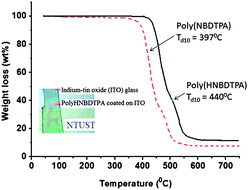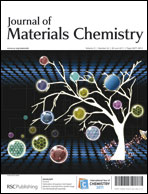Two novel near-infrared (NIR) electrochromic polynorbornenes, poly(NBDTPA) and poly(HNBDTPA), containing electroactive chromophores, were prepared via ring-opening metathesis polymerisation from a new norbornene derivative (NBDTPA) using Grubbs' catalysts followed by hydrogen reduction. The glass transition temperatures (Tg) of poly(NBDTPA) and hydrogenated poly(HNBDTPA) were 141 °C and 91 °C, respectively. The 10% weight-loss temperatures of hydrogenated poly(HNBDTPA) and poly(NBDTPA) were up to 440 °C and 397 °C, respectively. Hydrogenated poly(HNBDTPA) film showed excellent transparency (up to 91%). Poly(NBDTPA) showed a cyclic voltammogram and electrochromic behaviour that was similar to poly(HNBDTPA). The cyclic voltammogram of a poly(HNBDTPA) film cast onto an indium-tin oxide (ITO)-coated glass substrate exhibited three reversible oxidation redox couples at 0.63, 0.82 and 1.23 V vs. Ag/Ag+ in acetonitrile solution. The electrochromic characteristics of poly(HNBDTPA) showed excellent stability and reversibility, with multi-stage colour changes from its colourless neutral form to green, light-blue and dark-blue with applied potentials of 0 to 1.75 V. The colour switching time and bleaching time of the poly(HNBDTPA) were 7.1 s and 4.2 s in the near-infrared region (1230 nm), and 7.4 s and 4.5 s in the UV-vis region (420 nm), respectively.

You have access to this article
 Please wait while we load your content...
Something went wrong. Try again?
Please wait while we load your content...
Something went wrong. Try again?


 Please wait while we load your content...
Please wait while we load your content...